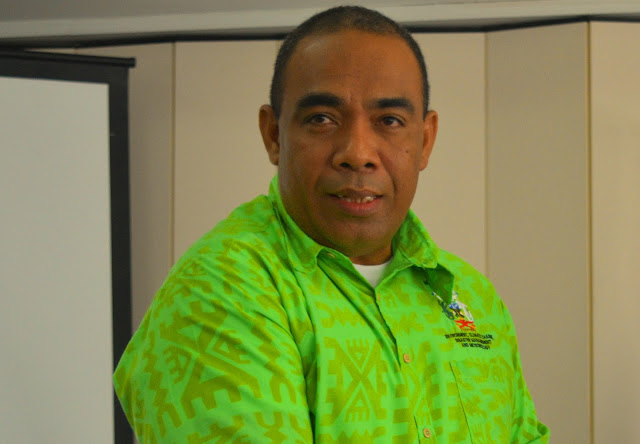HOSPITAL NIGHTMARE
20 beds, 60-100 patients per day at
the Emergency
BY MAVIS NISHIMURA PODOKOLO
The Emergency Department (ED) at the national referral hospital (NRH) sees 60 to 100 patients per day. This is with only 20 beds.
And, this imbalance in service versus
patients is doubling, says Dr George Malefoasi, chief executive officer of the
NRH.
Mr Malefoasi also indicated that such
overcrowding promotes more illness and death.
 |
| Dr George Malefoasi, chief executive officer of the NRH |
In trying to address this problem, NRH is resorting to med-term solutions such as buying more mattresses for the ED, discharging patients in time at the inpatient wards, and bed-sharing among the in-patient wards.
Recently, concerns were raised on
patients having to wait on the floor, or the benches at the nearby outpatient,
along the corridor, any space one could lay or sit on.
Replying to enquiries via email on the
matter last week, Malefoasi admits that “Bed shortage is an [on]going issue at
our main referral hospital here, as it is everywhere in the world”.
“The gap between the demand for health
care especial hospital beds is doubling whilst the number of beds are stagnant
or reduced due to unforeseen changes,” he explains.
“The Emergency Department is the point
of entry of most patients, once seen they are then referred for admission to
the in-patient teams depending on severity of illness or given treatment and
investigations ordered for follow up.
“The Emergency Department has 20 beds
and sees from 60-100 patients in a day.
“The admission rate is 13.6 [percent]
from the data in 2020, an increase from 12 [percent] from 2019.
“Admitted patients to the wards at
times can spend from [less than] 24 hours to up to [seven] days in the
Emergency Department waiting for a bed on the ward.
“This means that new patients presenting
that day to the Emergency department may not have a bed as it is already
occupied by those awaiting transfer to the ward.
“Studies such as that of Richardson. D
(2006). MJA 184.4, have shown that overcrowding in the Emergency increases the
chance of morbidity and mortality.”
Also contributing to the problem is
what Malefoasi termed as ‘access block’, in which patients referred for
admission by specialists in the in-patient wards cannot be provided any free
bed there due to ‘no free beds in the wards’.
“This back flow then contributes to
overcrowding due to no free beds in the ED and the wards.” Malefoasi explains.
Plans and
measures undertaken
“Doctors, nurses along with the
management are continuous engaging in monitoring, discussing and finding ways
to manage the bed demand and shortage issues as a daily routine as well as
longer strategic measures.
“The ideal situation is providing more
beds which means building additional wards and so on but this is medium and
long tern plan of the Solomon Islands Government.
“First, at the ED, the management is
buying additional mattresses for patients to used whilst proper beds are freed
up. Communications among departments and ED will be strengthened, and bed
management will be strengthened. Hence, a study on the patient flow in the
hospital will be undertaken soon in the few days’ time. The objective is to
identify local barriers to effective patient flow and provide recommendations
of potential strategies that may more effectively support patient flow.
“Secondly at the moment, at clinical
level (wards), nurses and doctors in-charge are ensuring patients are
discharged on time. The clinicians ensure the discharge protocols are followed,
and a diagnosis is reached quickly and right treatment prescribed as much as
possible within their allowed days of stay in the hospital.
“Third, there is a ‘bed sharing
measure’ which is activated so that patients from ED could be transferred for
admissions on time and help free up beds at the ED. Bed sharing will happen in
the wards to allow other department to accommodate other patients and secondly
there is a ward space identified for 1-2 beds to accommodate spill over of ED
patients without beds. This is short term and temporary measures whilst long
term change happened.
“One of measures still at a
negotiation and discussion stage with the Doctor at the Good Samaritan Hospital
and the Health Director for Guadalcanal province is to relocate long stay
patients from Guadalcanal Province there for completion of treatment and management
e.g. TB patients and Diabetic patients, which are currently occupying beds.”



Comments
Post a Comment